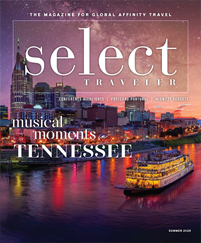“Ceadmile failte.”
Owen Flynn greeted us at the Dublin Airport with “a hundred thousand welcomes” in Irish.
My wife, Marcheta, and I had arrived with 32 others in early October on a Taste of Ireland tour with Fancy-Free Holidays. Flynn would be our witty and informative motorcoach driver and guide for the next eight days through southeastern and southwestern Ireland; during that time, we would sample that fascinating island’s history, culture, magnificent scenery and captivating and friendly people, which he epitomized.
“It’s called Taste of Ireland because we want to whet your appetite so you will know what to do when you go back,” said Sandi Pufahl, owner of the Naperville, Illinois-based tour company. “There are no ‘ifs’ but ‘when’ you go back.”
A Perfect Pint
The first stop on the Emerald Isle was at the mammoth Guinness Storehouse in Dublin, a multistory interactive visitors center in a former grain warehouse of the maker of Ireland’s world-famous black stout.
“We are a working brewery. We make 3 million pints of Guinness a day,” said Beth, who gave us a guided tour of the crowded facility, which is shaped like a large pint of Guinness.
During the tour, we learned how Guinness combines barley, hops, yeast and water from the Wicklow Mountains into its famous brew and how to pour and drink it.
“It must be drunk cold,” said Beth. “When you pour, you hear the foam hiss. That’s gas. It’s not just a sense of taste, but also smell. And drink with your eyes as well. Drink under the head, which should end up at the bottom of the glass.
“This is the freshest Guinness you will taste in your life.”
The tour offers a free pint of Guinness, which can be sampled in the seventh-floor Gravity bar, which provides a panoramic, 360-degree view of the Dublin skyline. We didn’t see any towering skyscrapers because no building in Dublin can be taller than the spire of Christ Church Cathedral.
Dublin is a combination of ancient traditions dating to its founding by the Vikings and youthful vibrancy; the average age of Ireland’s residents is 38.
Trinity College, founded in the 1500s by Queen Elizabeth I, brings both together. The collegiate energy was evident as we headed across a large central courtyard filled with students to the 18th-century Old Library, which houses the Book of Kells, a lavishly decorated Latin copy of the four gospels of the New Testament dating from the ninth century.
Two pages of the book, produced on velum, are displayed in subdued light. An exhibit as you enter tells the history of the book, along with the books of Armagh and Durrow.
Upstairs, the college’s famous 213-foot Long Room, with its two-story barrel-vaulted ceilings and two levels of bookcases, houses 200,000 of the library’s oldest books.
It’s appropriate that the library would be in Dublin, a UNESCO City of Literature. Sites associated with famous authors abound, among them two modernistic bridges over the River Liffey named for James Joyce and Samuel Beckett; the Abbey Theater, founded by W.B. Yeats; a statue of Oscar Wilde in the park across from our hotel; a statue of George Bernard Shaw in the National Gallery, to which he made a large bequest; and the death mask and grave of Jonathan Swift in St. Patrick’s Cathedral. There’s even a Writers Museum.
Monks and Mills
Our first stop outside Dublin was Glendalough, a glacial valley in County Wicklow that has the ruins of a monastic settlement founded in the sixth century by St. Kevin.
“It was not a monastery in the traditional sense; it was a major economic center,” said Flynn, who also explained that workshops, an infirmary, guesthouses, farm buildings and dwellings for the monks added commercial activity to the religious site.
Most of the remaining mortared stone churches and buildings date from the 10th to 12th centuries. We walked in a steady rain through the large arched stone gateway and an ancient cemetery, still used today, to the 98-foot round stone tower and to the stone-roofed St. Kevin Church, where we got respite from the downpour.
After a lunch stop and guided tour of Avoca Handweavers, Ireland’s oldest woolen mill, which dates to 1723, we spent the night in Kilkenny. The next morning, we were exposed to another famous Irish spirit — whiskey at Jameson’s Midleton Distillery.
The visitor center is in the section of the distillery that was used for 150 years before a modern new distillery was built next door in 1975. Our tour took us through the five-story grain store, the 1794 mill building with its cast-iron waterwheel that powered five sets of millstones and the distillation building, which houses the 32,000-gallon copper pot still, the largest of its kind in the world.
“It has been here since 1825,” said Bernadette, our guide. “The building had to be built around it. Distillation is the heart of Irish whiskey, which is distilled three times.”









